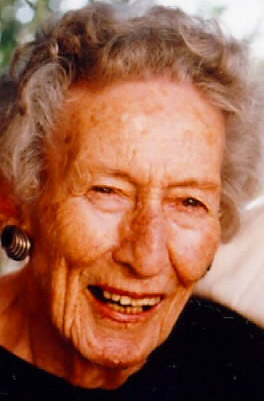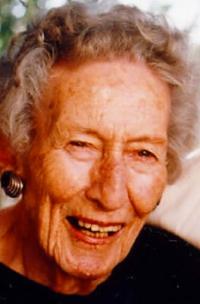Yndia Smalley Moore had a knack for telling a great story. She acquired this talent from her father, George Smalley, journalist and editor of Arizona newspapers, including the Tucson Citizen. He regaled his children with outrageous tales of bank robbers, cattle rustlers and murderers who roamed the territory. Her mother, Lydia Roca Smalley, was a Tucson native.
Born in Tucson on June 28, 1902, Yndia spent most of her childhood in the rowdy community of Globe.
“Globe, when I was a little girl,” she said in a 1966 interview, “was a rough, tough mining town. There were streets where we could not go. We took violent death as a matter of fact. … I remember my father reading a letter at breakfast telling of the death of his aunt — back in the Midwest. ‘Who shot her?’ I piped up. It never occurred to me that anyone died a natural death.”
Once, when her parents were away, the maid, swearing Yndia to secrecy, took her to view a public hanging. Yndia thought it was a fun way to spend the afternoon.
“My father told wonderful stories,” she said, “and — probably by the process of osmosis — I just simply soaked up firsthand information about Arizona.”
She was attending Tucson High School when the 1918 influenza epidemic consumed the nation and the world. Forced to stay home as the schools, as well as most of the town, closed down, she entered Northern Arizona University at age 16 and received her state teaching certificate the following year. She taught in a one-room schoolhouse in the mining community of Greaterville in the Santa Rita Mountains before enrolling at the University of Arizona.
In 1926, Yndia and Malcolm Cummings, son of university President Byron Cummings, partnered to open a Mexican themed tearoom they called La Cazuela — the Cooking Pot — on Tucson’s South Sixth Avenue. They headed to Nogales to purchase authentic accoutrements for the restaurant — dishes, chairs and tables. With sawdust on the floor, they served authentic Mexican food by candlelight. The restaurant even had a pet parrot that spoke Spanish.
The Smalley family cook went to work for the restaurant and supposedly created her own version of the Mexican dessert Almendrado, substituting almond-flavoring for lemon in this sweet pudding and lacing it with a heavy hand of bourbon.
The tearoom attracted personalities from all walks of life including authors Sinclair Lewis and John Galsworthy, but it was doomed to failure when bootleggers opened a saloon down the street and took away most of their business.
The cook took her now-famous dessert to El Charro Restaurant.
In 1930, Yndia married Army Col. James P. Moore, a member of then Gen. Dwight D. Eisenhower’s staff, and the couple traveled extensively until John’s death in 1946. Yndia returned to Tucson with her teenage daughter, Dianne, who had been born in Tucson in 1932.

Yndia Smalley Moore was honored as La Doña del Dia during Tucson's five-day birthday celebration in 1975.
She acquired a job with the Tucson Fine Arts Commission, eventually becoming director of what is now the Tucson Museum of Art.
In 1954, she went to work for the Arizona Historical Society Museum, initially called the Arizona Pioneers Historical Society. Within a short period, she was named curator, and five years later, she became executive director of the museum.
“Tucson is destined to become one of the most exciting and valuable research centers of the West,” she said in 1961. “This research center and its archives are considered to be among the finest relating to Southwestern Americans.”
Yndia’s interest in Arizona history prompted her to introduce the idea of establishing a periodical to retain the stories of Arizona historians. She is credited with being involved with the founding of the Journal of Arizona History, formerly known as Arizoniana. Through the years, she contributed her own articles to the publication expounding the history of the territory and the state.
Retiring from the Historical Society in 1964, Yndia was not yet through exploring early Arizona. She became historical editor of the Tucson Citizen, writing a popular weekly column about Tucson’s past. She was also a staff writer for the Magazine Tucson.
She continued to serve on the Arizona Historical Society Board and the Tucson Heritage Foundation as well as being a member of the Tucson Historical Roundtable.
In 1966, long after George Smalley’s death, Yndia gathered up her father’s papers and notes that he had accumulated through his years as a reporter, editor and consummate adventurer and compiled them into a book titled “My Adventures in Arizona: Leaves from a Reporter’s Notebook,” published by the Arizona Pioneers Historical Society.
Because of her unfailing interest in Arizona history and her endeavors to record the diverse richness of the state, Yndia was recognized as La Doña del Dia (Lady of the Day) in 1975 during Tucson’s Bicentennial celebration. The honorary title is given to women who have dedicated their lives to service within their community and to their families.
Hoping she could fill the shoes of La Doña, Yndia placed the gift of a mantilla from Spain on her head and admitted she did not particularly like being the center of attention, but “I will try to behave,” she said.
The Arizona State Senate recognized Yndia’s efforts to preserve Arizona’s history in 1987 by presenting her with the Spirit of Arizona Award. In 1991, the Tucson Young Women’s Christian Association honored her with the Women on the Move Lifetime Achievement Award. In 1994, she was selected to receive the Sharlot Hall Award.
When Yndia died on Jan. 13, 1997, one of her friends acknowledged that even at age 94, Yndia “took the lead; she never followed.” Anthropologist and historian Bernard Fontana called her a “walking encyclopedia of Tucson — not just from reading about it, but from living it. … She had a wonderful sense of place and continuity of past and present.”
Yndia probably knew more about the history of Tucson than any historian of her time and generously shared her knowledge with those who continue to follow in her footsteps.






